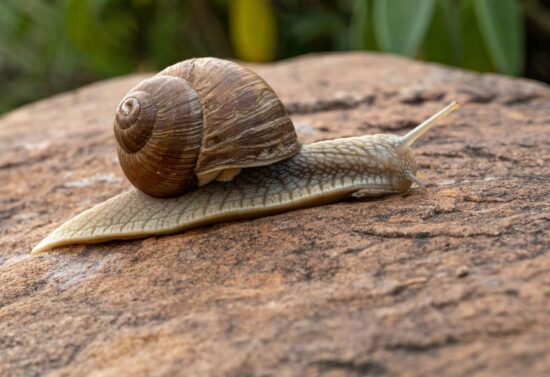Snails can turn a beautiful garden into a nightmare. These slimy creatures munch through leaves, destroy seedlings, and leave gross trails everywhere they go. If you’re tired of watching your plants get eaten overnight, you’re in the right place.
Learning how to get rid of snails doesn’t have to be complicated or expensive. Many effective methods use simple household items or natural techniques that won’t harm your family, pets, or the environment. The key is using several different approaches together for the best results.
1. Hand-Pick Snails for Immediate Results
The simplest way to start getting rid of snails is to pick them up by hand. This might sound gross, but it works really well for small gardens or when you first notice a problem.
The best time to hunt for snails is early in the morning or in the evening when they’re most active. Bring a flashlight if you’re going out after dark. Look under rocks, boards, flower pots, and anywhere dark and damp. Snails love hiding in these spots during the day.
Wear gloves if touching snails bothers you. Drop them into a container and move them far away from your garden. You can also put them on your compost pile where they might actually help break down organic matter.
Check your garden every day for the first week or two. Once you remove most of the adult snails, you’ll see fewer problems right away.
2. Create Physical Barriers with Copper
Copper creates a natural barrier that snails hate to cross. When their slimy bodies touch copper, it creates a small electrical charge that feels uncomfortable to them.
You can buy copper tape at most garden centers or hardware stores. Stick the tape around the rim of plant pots or along the edges of raised garden beds. Make sure the copper forms a complete circle with no gaps.
For individual plants, try wrapping thin copper wire around the stem about two inches up from the ground. Twist the ends together but don’t make it too tight since the plant will grow.
Keep the copper clean and make sure no plant leaves touch the ground outside the barrier. Snails are smart and will use leaves as bridges to get over your copper fence.
3. Use Diatomaceous Earth as a Natural Barrier
Diatomaceous earth sounds fancy, but it’s just a powder made from tiny fossilized sea creatures. The powder has microscopic sharp edges that cut into snail bodies as they try to crawl over it.
Buy food-grade diatomaceous earth from a garden center or online. Sprinkle it in a thick line around plants you want to protect. Make the line at least an inch wide so snails can’t easily jump over it.
You’ll need to reapply the powder after it rains or when you water your plants. The powder only works when it’s dry, so timing matters.
This method is completely safe for kids and pets when you use food-grade diatomaceous earth. Just avoid breathing in the dust when you’re applying it.
4. Set Up Beer Traps
Snails love beer just as much as some people do. You can use this to your advantage by creating simple traps that lure snails away from your plants.
Take a shallow container like a margarine tub or pie tin and bury it in the soil so the rim sits level with the ground. Fill it about halfway with any kind of beer. Cheap beer works just as well as expensive stuff.
Place these traps around the edges of your garden beds, not right next to your plants. You want to catch snails before they reach your vegetables or flowers.
Check the traps every morning and empty out any drowned snails. Refill with fresh beer every few days since the smell gets weaker over time. If you don’t drink beer, a mixture of sugar, water, and yeast works almost as well.
5. Use Kitchen Waste Deterrents
Two common kitchen items can help with getting rid of snails: coffee grounds and vinegar. Both work in different ways but are completely natural and safe.
Coffee Grounds: Save your used coffee grounds and sprinkle them around plants that snails like to eat. The caffeine in coffee is toxic to snails, and the rough texture makes it uncomfortable for them to crawl over. The grounds also add nitrogen to your soil as they break down, which plants love.
Vinegar Solution: Mix equal parts white vinegar and water in a spray bottle. Spray this around the edges of garden beds and anywhere you see snail trails. The acid in vinegar kills snails on contact by causing them to dehydrate quickly.
Be careful not to spray vinegar directly on plant leaves since it can damage them. Both coffee grounds and vinegar need to be reapplied after rain washes them away.
6. Create Abrasive Barriers
Snails have soft, sensitive bodies that don’t like crawling over sharp or rough surfaces. You can use this weakness to protect your plants with materials that feel uncomfortable under their slimy bellies.
Crushed Eggshells: Save eggshells from cooking and let them dry completely. Crush them into small pieces and sprinkle around plants. The sharp edges discourage snails from crossing over them.
Other Rough Materials: Coarse sand, crushed oyster shells, wood chips, or volcanic rock all work the same way. Create a border around individual plants or entire garden beds.
Some gardeners swear by these methods while others find that snails just produce more slime to protect themselves and crawl right over. Try different materials to see what works best in your garden.
Make sure to refresh these barriers regularly since rain and watering can wash them away or make them less effective.
7. Use Nematode Biological Control
Nematodes are tiny worms that you can’t see without a microscope. They’re like having an invisible army working to get rid of snails in your garden. The specific type you want is called Phasmarhabditis hermaphrodita.
These helpful worms live in the soil and hunt for slugs and snails. When they find one, they enter the snail’s body and release bacteria that kills it within a week or two. The snails stop eating within just a few days.
You can buy nematodes online or at some garden centers. They come as a powder that you mix with water and apply with a watering can or sprayer. The soil needs to be moist and the temperature should be between 40 and 70 degrees Fahrenheit.
One application protects your garden for about six weeks. Nematodes are completely safe for kids, pets, and beneficial insects. The main downside is cost since treating a large garden can get expensive.
8. Plant Natural Repellent Plants
Some plants naturally repel snails with their strong scents or tough textures. Adding these to your garden creates a living barrier that looks beautiful and smells great to humans.
Aromatic Herbs: Rosemary, lavender, mint, thyme, and sage all have strong scents that snails avoid. Plant these around the edges of vegetable beds or between plants that snails usually target.
Allium Family: Garlic, onions, and chives work well as companion plants. Their sulfur compounds create smells that snails find unpleasant.
Textured Plants: Lamb’s ears and other plants with fuzzy or tough leaves are naturally resistant to snail damage. The texture feels uncomfortable on their soft bodies.
You can also harvest some of these herbs to make homemade sprays. Steep garlic or herbs in water for a few days, then strain and spray the liquid around your garden.
9. Encourage Natural Predators
Nature has its own way of controlling snail populations. By making your garden friendly to animals that eat snails, you get free pest control that works around the clock.
Birds: Many bird species love eating snails and slugs. Set up bird baths, feeders, and nesting boxes to attract them to your garden. Thrushes are especially good at cracking open snail shells.
Ground Animals: Frogs, toads, and hedgehogs all eat lots of snails. Create hiding spots with rocks, logs, or brush piles. A small pond or water feature attracts frogs and toads.
Beneficial Insects: Ground beetles hunt snails at night when the pests are most active. Avoid using pesticides that might harm these helpful insects.
The more diverse your garden ecosystem becomes, the better it can control pest problems naturally. This approach takes time to work but creates long-term balance.
10. Use Commercial Iron Phosphate Baits
If natural methods aren’t working fast enough, organic iron phosphate baits provide a stronger solution that’s still relatively safe for the environment.
Products like Sluggo contain iron phosphate, which acts as a stomach poison for snails and slugs. When they eat the bait, they stop feeding immediately and die within a few days.
Sprinkle the pellets sparingly around affected plants. Don’t use them like fertilizer since a little goes a long way. The baits work in wet weather, unlike some other treatments.
These products are approved for organic gardening and are much safer than old-style metaldehyde baits. However, they’re not completely harmless. They can affect earthworms and may cause problems if pets eat large amounts.
Always read and follow label directions carefully. Store baits safely away from children and pets.
11. Garden Management and Trapping Strategies
Smart gardening practices make your yard less attractive to snails while giving you more ways to catch the ones that do show up.
Watering Changes: Water your garden in the morning instead of evening. This lets the soil surface dry out by nighttime when snails are most active. Use drip irrigation or soaker hoses instead of sprinklers to keep water off plant leaves.
Habitat Modification: Remove hiding places like stacks of pots, boards, or piles of debris where snails spend their days. Trim back dense vegetation that stays damp. Improve air circulation by spacing plants properly.
Trap Crops: Plant things snails love to eat, like marigolds or lettuce, away from your main garden. Check these “sacrifice plants” daily and remove any snails you find.
Simple Traps: Place boards, cardboard, or grapefruit rinds around the garden. Snails will hide under them during the day, making collection easy. Empty these traps every morning.
Conclusion
Getting rid of snails takes patience and persistence, but you don’t need expensive chemicals or complicated equipment. The methods that work best combine several different approaches.
Start with the simplest techniques like hand-picking and barriers, then add biological controls or baits if needed. Remember that how to get rid of snails effectively depends on your specific situation, garden size, and local snail population.
Natural predators and good garden hygiene provide the best long-term solution. While getting rid of snails completely might not be realistic, you can definitely reduce their numbers enough to protect your plants and enjoy your garden again.
The key is staying consistent with whichever methods you choose. Check your garden regularly, maintain barriers and traps, and don’t get discouraged if you don’t see instant results. With time and effort, you’ll win the battle against these slimy garden pests.


